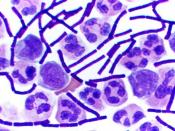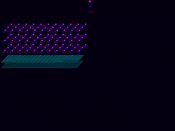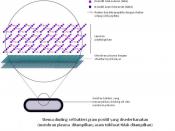Bacterial Cell Wall Composition
Almost all bacteria have cell walls surrounding the cell membranes. This cell wall helps to do important functions, like confer cell shape, and protect the cell from lysis when in low solute environments. There are three classifications used in describing cell walls: Gram Positive (Gram+), Gram Negative (Gram-) and Acid-Fast. These membranes share a common part in their structure, however--an interlocked layer of peptidoglycan. Peptidoglycan is a molecular complex made from two sugar monomers: N-acetylmuramic acid (NAM) and N-acetylglucosamine (NAG).
NAM and NAG are strung together to form a chain. Several of these chains are built side-by-side and then are bonded, or cross-linked, forming a layer. Each of these layers is, in turn, cross-linked to each other in the same fashion that the chains were linked into layers. In other words, the NAM and NAG are bound together into threads. These threads are then tied together to form a mat.
The mats are laid on top of another and tied together to form the peptidoglycan of the cell wall.
The number of layers in the peptidoglycan differs strongly between Gram+ and Gram- (and Acid-Fast) cell walls.
Think Positive: The Gram-Positive Cell Wall
Gram+ cell walls have a distinctly thick layer of peptidoglycan (which contrasts with the thin layer in Gram- and Acid-Fast--more on that later). Teichoic and Lipoteichoic acids run throughout the layers of the peptidoglycan. Teichoic acid is a polymer made from Ribitol-phosphate and/or glycerol-phosphate. Lipoteichoic acid is a teichoic acid attached to a lipid, which is seated in the cell membrane. Teichoic acid is often used by the immune system as an antigen. Some Gram+ cell walls also have teichuronic acid, which is made from two or more repeating subunits, one of which is a derivative of uronic acid. Various proteins are...


